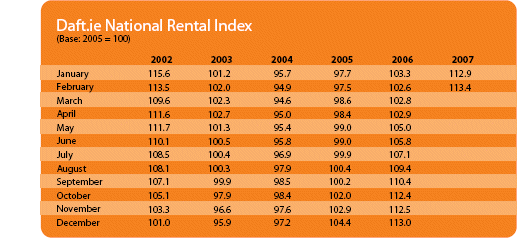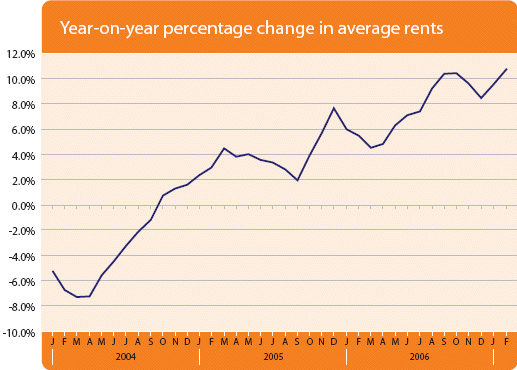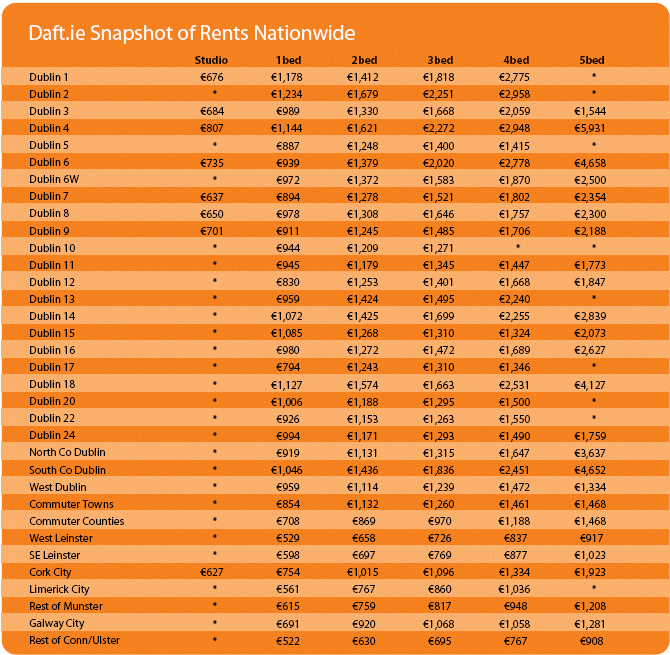Rental Market is in Rude Health
Daft Reports
- Ronan Lyons (House Price, Q1 2024)
- Ronan Lyons (Rental Price, Q4 2023)
- Ronan Lyons (House Price, Q4 2023)
- Ronan Lyons (Rental Price, Q3 2023)
- Ronan Lyons (House Price, Q3 2023)
- Ronan Lyons (Rental Price, Q2 2023)
- Ronan Lyons (House Price, Q2 2023)
- Ronan Lyons (Rental Price, Q1 2023)
- Ronan Lyons (House Price, Q1 2023)
- Ronan Lyons (Rental Price, Q4 2022)
- Ronan Lyons (House Price, Q4 2022)
- Ronan Lyons (Rental Price, Q3 2022)
- Ronan Lyons (House Price, Q3 2022)
- Ronan Lyons (Rental Price, Q2 2022)
- Ronan Lyons (House Price, Q2 2022)
- Ronan Lyons (Rental Price, Q1 2022)
- Ronan Lyons (House Price, Q1 2022)
- Ronan Lyons (Rental, Q4 2021)
- Ronan Lyons (House Price, Q4 2021)
- Ronan Lyons (Rental, Q3 2021)
- Ronan Lyons (House Price, Q3 2021)
- Ronan Lyons (Rental, Q2 2021)
- Ronan Lyons (House Price, Q2 2021)
- Ronan Lyons (Rental, Q1 2021)
- Ronan Lyons (House Price, Q1 2021)
- Ronan Lyons (Rental, Q4 2020)
- Ronan Lyons (House Price, Q4 2020)
- Ronan Lyons (Wealth, H2 2020)
- Ronan Lyons (Rental, Q3 2020)
- Ronan Lyons (House Price, Q3 2020)
- Ronan Lyons (Housing, July 2020)
- Ronan Lyons (Housing, June 2020)
- Ronan Lyons (Housing, May 2020)
- Ronan Lyons (Rental, Q1 2020)
- Ronan Lyons (House Price, Q1 2020)
- Ronan Lyons (Rental, Q4 2019)
- Ronan Lyons (House Price, Q4 2019)
- Ronan Lyons (Wealth, H2 2019)
- Ronan Lyons (Rental, Q3 2019)
- Ronan Lyons (House Price, Q3 2019)
- Pierre Yimbog (Rental, Q2 2019)
- Ronan Lyons (House Price, Q2 2019)
- Ronan Lyons (Wealth, H1 2019)
- Ronan Lyons (Rental, Q1 2019)
- Ronan Lyons (House Price, Q1 2019)
- Ronan Lyons (Rental, Q4 2018)
- Ronan Lyons (House Price, Q4 2018)
- Ronan Lyons (Wealth, H2 2018)
- Ronan Lyons (Rental, Q3 2018)
- Ronan Lyons (House Price, Q3 2018)
- Shane De Rís (Rental, Q2 2018)
- Ronan Lyons (House Price, Q2 2018)
- Ronan Lyons (Wealth, 2018)
- Ronan Lyons (Rental, Q1 2018)
- Ronan Lyons (House Price, Q1 2018)
- Ronan Lyons (Rental, Q4 2017)
- Ronan Lyons (House Price, Q4 2017)
- Ronan Lyons (Rental, Q3 2017)
- Ronan Lyons (House Price, Q3 2017)
- Katie Ascough (Rental, Q2 2017)
- Ronan Lyons (Wealth, 2017)
- Ronan Lyons (House Price, Q2 2017)
- Ronan Lyons (Rental, Q1 2017)
- Ronan Lyons (House Price, Q1 2017)
- Ronan Lyons (Rental, Q4 2016)
- Ronan Lyons (House Price, Q4 2016)
- Ronan Lyons (Rental, Q3 2016)
- Ronan Lyons (House Price, Q3 2016)
- Ronan Lyons (School Report, 2016)
- Conor Viscardi (Rental, Q2 2016)
- Ronan Lyons (Rail Report, 2016)
- Ronan Lyons (House Price, Q2 2016)
- Ronan Lyons (Rental, Q1 2016)
- Ronan Lyons (House Price, Q1 2016)
- Ronan Lyons (Rental, Q4 2015)
- Ronan Lyons (House Price, Q4 2015)
- Ronan Lyons (Rental, Q3 2015)
- Ronan Lyons (House Price, Q3 2015)
- Marcus O'Halloran (Rental, Q2 2015)
- Ronan Lyons (House Price, Q2 2015)
- Ronan Lyons (Rental, Q1 2015)
- Ronan Lyons (House Price, Q1 2015)
- Ronan Lyons (Rental, Q4 2014)
- Ronan Lyons (House Price, Q4 2014)
- Ronan Lyons (Rental, Q3 2014)
- Ronan Lyons (House Price, Q3 2014)
- Domhnall McGlacken-Byrne (Rental, Q2 2014)
- Ronan Lyons (House Price, Q2 2014)
- Ronan Lyons (Rental, Q1 2014)
- Ronan Lyons (House Price, Q1 2014)
- Ronan Lyons (Rental, Q4 2013)
- Ronan Lyons (House Price, Q4 2013)
- Ronan Lyons (Rental, Q3 2013)
- Ronan Lyons (House Price, Q3 2013)
- Ronan Lyons (Rental, Q2 2013)
- Ronan Lyons (House Price, Q2 2013)
- Ronan Lyons (Rental, Q1 2013)
- Ronan Lyons (House Price, Q1 2013)
- Ronan Lyons (Rental, Q4 2012)
- Ronan Lyons (House Price, Q4 2012)
- Lorcan Sirr (Rental, Q3 2012)
- Padraic Kenna (House Price, Q3 2012)
- John Logue (Rental, Q2 2012)
- Ronan Lyons (House Price, Q2 2012)
- Barry O'Leary (Rental, Q1 2012)
- Seamus Coffey (House Price, Q1 2012)
- Joan Burton (Rental, Q4 2011)
- Ronan Lyons (House Price, Q4 2011)
- Philip O'Sullivan (Rental, Q3 2011)
- Sheila O'Flanagan (House Price, Q3 2011)
- Rachel Breslin (Rental, Q2 2011)
- Constantin Gurdgiev (House Price, Q2 2011)
- Cormac Lucey (Rental, Q1 2011)
- Eoin Fahy (House Price, Q1 2011)
- Lorcan Roche Kelly (Rental, Q4 2010)
- Ronan Lyons (House Price, Q4 2010)
- John Fitzgerald (Rental, Q3 2010)
- Patrick Koucheravy (House Price, Q3 2010)
- Gary Redmond (Rental, Q2 2010)
- Jim Power (House Price, Q2 2010)
- Jill Kerby (Rental, Q1 2010)
- Brian Lucey (House Price, Q1 2010)
- Michael Taft (Rental, Q4 2009)
- Alan McQuaid (House Price, Q4 2009)
- Dr. Charles J. Larkin (Rental, Q3 2009)
- Emer O'Siochru (House Price, Q3 2009)
- Ronan Lyons (Rental, Q2 2009)
- Oliver Gilvarry (House Price, Q2 2009)
- Brian Devine (Rental, Q1 2009)
- Dr. Liam Delaney (House Price, Q1 2009)
- Gerard O'Neill (Rental, Q4 2008)
- Ronan Lyons (House Price, Q4 2008)
- Dr. Stephen Kinsella (Rental, Q3 2008)
- Moore McDowell (House Price, Q3 2008)
- Shane Kelly (Rental, Q2 2008)
- Fergal O'Brien (House Price, Q2 2008)
- Eoin O'Sullivan (Rental, Q1 2008)
- Dermot O'Leary (House Price, Q1 2008)
- Dan O'Brien (Rental, Q4 2007)
- Frances Ruane (House Price, Q4 2007)
- John McCartney (Rental, Q3 2007)
- Ronnie O'Toole (House Price, Q3 2007)
- Ronan Lyons (Rental, Q2 2007)
- Constantin Gurdgiev (House Price, Q2 2007)
- Fintan McNamara (Rental, Q1 2007)
- Rossa White (House Price, Q1 2007)
- Geoff Tucker (Rental, Q4 2006)
- Damien Kiberd (House Price, Q4 2006)
- Pat McArdle (House Price, Q3 2006)
- Marc Coleman (House Price, Q2 2006)
- David Duffy (House Price, Q1 2006)
- Austin Hughes (House Price, Q4 2005)
- David McWilliams (House Price, Q2 2005)

15th Mar 2007
Geoff Tucker is our guest blogger, commenting on the latest Daft research on the Irish property market.
The latest analysis of the rental market contained in this edition of the Daft Report shows rental values continuing to increase steadily right across the country, with the annual rate of growth reaching 10.5 per cent in February 2007 - the fastest growth rate since the index started tracking rents back at the beginning of 2002. Rental values have been increasing since the end of 2004, though it wasn't until the middle of last year that the pace of growth really picked up and reached double figures.
It comes as no surprise to see the biggest jump in rents over the last twelve months occurring in Dublin 2. Here the average rent for a one bedroom home increased by 24.3 per cent to €1,234 per month and by 19.7 per cent to €1,679 per month for a two bedroom home. Two bedroom homes in Dublin 18 also registered a significant jump in rental values, rising by 18.8 per cent to €1,574 per month. This post code includes locations such as Sandyford, Stepaside, Kilternan and Carrickmines that benefit from being close to major centres of employment and good transportation links that provide easy access to the city centre. The increase in rental values reflects a variety of factors at work, but is primarily due to the strength of tenant demand, which is linked to the sustained growth in population and high levels of inward migration, especially in Dublin. Alongside this, supply constraints in some key urban locations have led to further upward pressure on rents while the substantially improved quality of product on offer, with modern, well fitted-out apartments replacing the traditional older bedsits/flats, has also had its effect.
The strong performance in the rental market has continued to encourage investors to purchase residential property. In the new homes market investors account for just over one-quarter of all purchasers, compared to around 20 per cent only two years ago. The continuing presence of investors is a major vote of confidence for the Irish residential market. The investor plays a vital role in the residential market, supplying much needed accommodation to the private rented sector, which accounts for approximately one-in-nine private households nationally and one-in-five in Dublin.
Yields on residential property (the annual rental income generated as a proportion of the overall property value) have increased for almost all accommodation types in Dublin during the past six months, reflecting the growth in rents and very little change in property values. Changes in yields outside Dublin tend to vary depending on location, increasing for most accommodation types in Galway City and falling in Limerick City. Yet for most investors, long-term capital gain is the primary objective, with many planning to use their property investment to fund their retirement or as a nest-egg for their children. Figures from Hooke & MacDonald confirm this and show that three quarters of investors purchasing new homes last year plan to hold on to their property for more than five years and half for more than ten years. Therefore, the prospect of a couple of years of single-digit growth rates in the Irish residential property market is unlikely to deter investors and is in fact far more sustainable in the long run.
Investors rate rental potential, access to public transport and potential for long-term capital appreciation as the most important factors influencing their choice of property. As a result, it is not surprising to see the majority investors purchasing properties in city centre areas - the traditional core of the rental market - or in suburban locations that are along key public transport routes and are easily accessible to major centres of employment.
The growth in rental values is expected to continue throughout 2007, rising by an average of 10 per cent this year, primarily driven by the demand for good quality accommodation. This, along with the final wave of SSIAs to be released later in the year, will ensure that investor activity remains strong right through the remainder of the year.
The Daft Report also highlights the importance of the rental market in helping first-time buyers reduce their monthly mortgage repayments through renting out a room. Figures from Hooke & MacDonald show that one in every four first-time buyers purchasing a new home last year planned to rent out a room, including 40 per cent for first-time buyers purchasing on their own. Given the current upward trend in rental values, an increase in the Rent-a-room Scheme income limit to €1,000 per month (currently €635 per month) would be an appropriate policy response and should be implemented as soon as possible.
Finally, this edition of the Daft Report provides a snapshot of new home prices for the first time, of which there are currently over 25,000 units available in over 3,000 new developments on the Daft.ie website. There is some variation in prices between the new and second-hand markets, though this in part can be explained by the varying degree of the quality of stock in the second-hand market and the fact that the majority of new homes are exempt from stamp duty provided the purchaser plans to live in it. This is one of the many reasons new homes are so popular with first-time buyers.
In the region of 80,000 new homes will be built across the country this year and while this represents a reduction on last year's figure, it is still a remarkable level of output. The favourable economic outlook - sustained levels of job creation, strong wage growth, maturing SSIAs, buoyant consumer spending - and the continued increase in population will ensure demand remains strong. Average price growth of 5 per cent looks likely this year, which is a far more sustainable rate of increase than the double-digit growth rates of last year. Even after taking into account the last two recent interest rate increases, affordability for first-time buyers actually improved in the first couple of months of 2007, thanks in large part to the changes in mortgage interest relief for first-time buyers announced in Budget 2007. The benign outlook for interest rates in the year ahead, with at most one more rise expected before the ECB will put rates on hold for an extended period, and the more moderate pace of price growth should see affordability improve again in the latter half of 2007. To sum up, the residential property market is performing well, particularly when compared to spring 2004 and 2005 rather than the overheated market environment dominated by spiralling prices in spring 2006. Bricks and mortar have consistently proved to be a reliable long-term investment - nothing has changed in this respect.
HIGHLIGHTS:

The Daft.ie National Rent Index

Irish Rental Market Growth 2004-2007
SNAPSHOT:

Average Rents across Ireland in March 2007
* Warning: This snapshot provides a highly generalised view of the rental market and is based on many thousands of properties advertised on Daft.ie between December 06 and February 07. These figures should be used as a guide only and should not be used to set rental levels as many qualitative factors affect rental prices besides area
